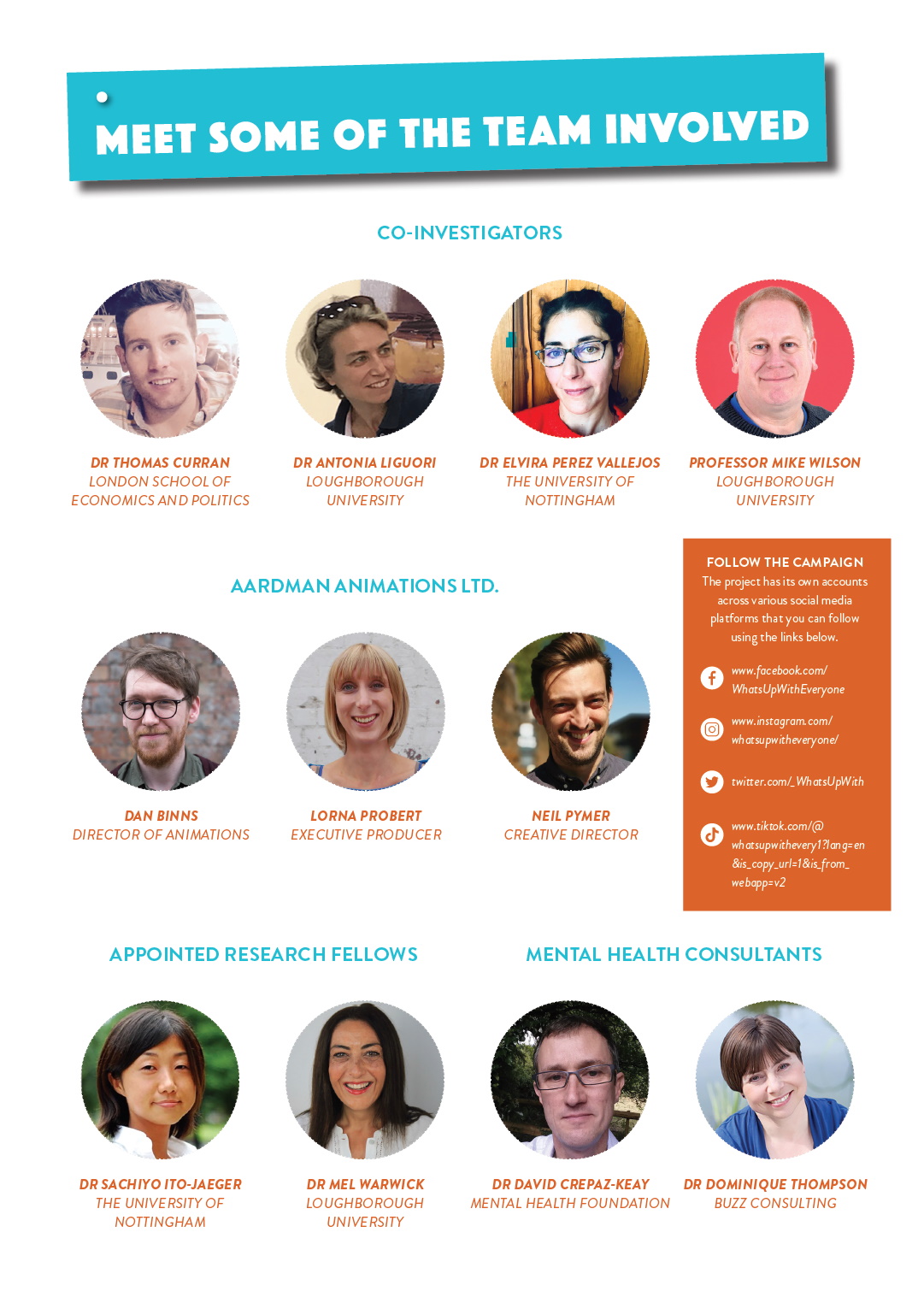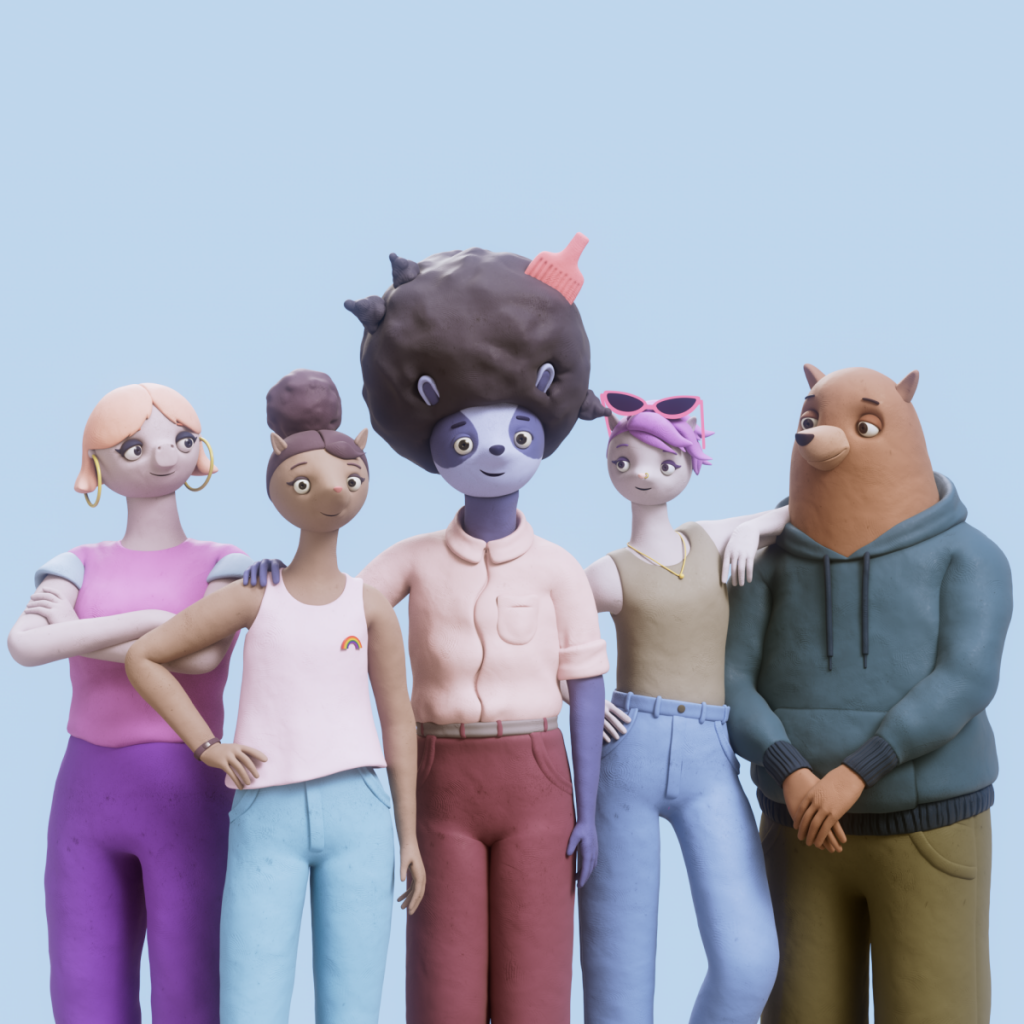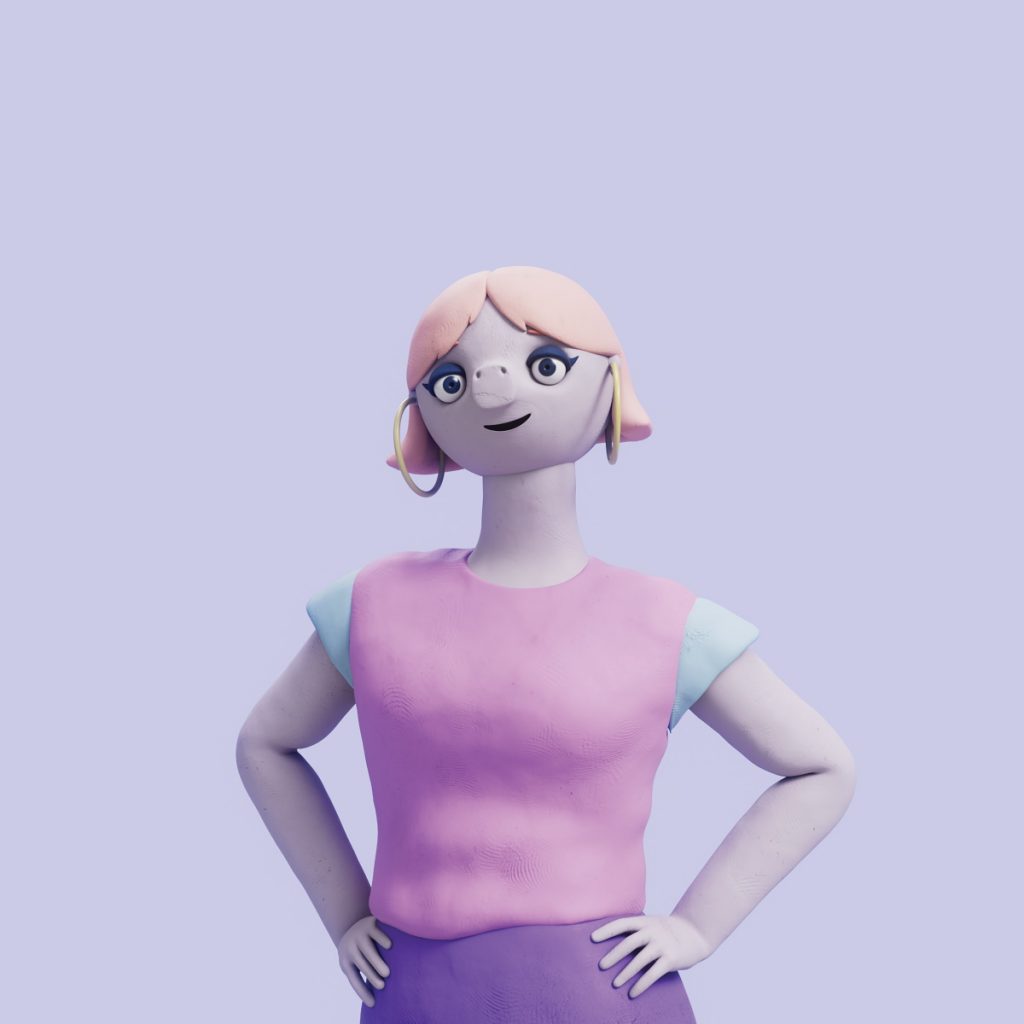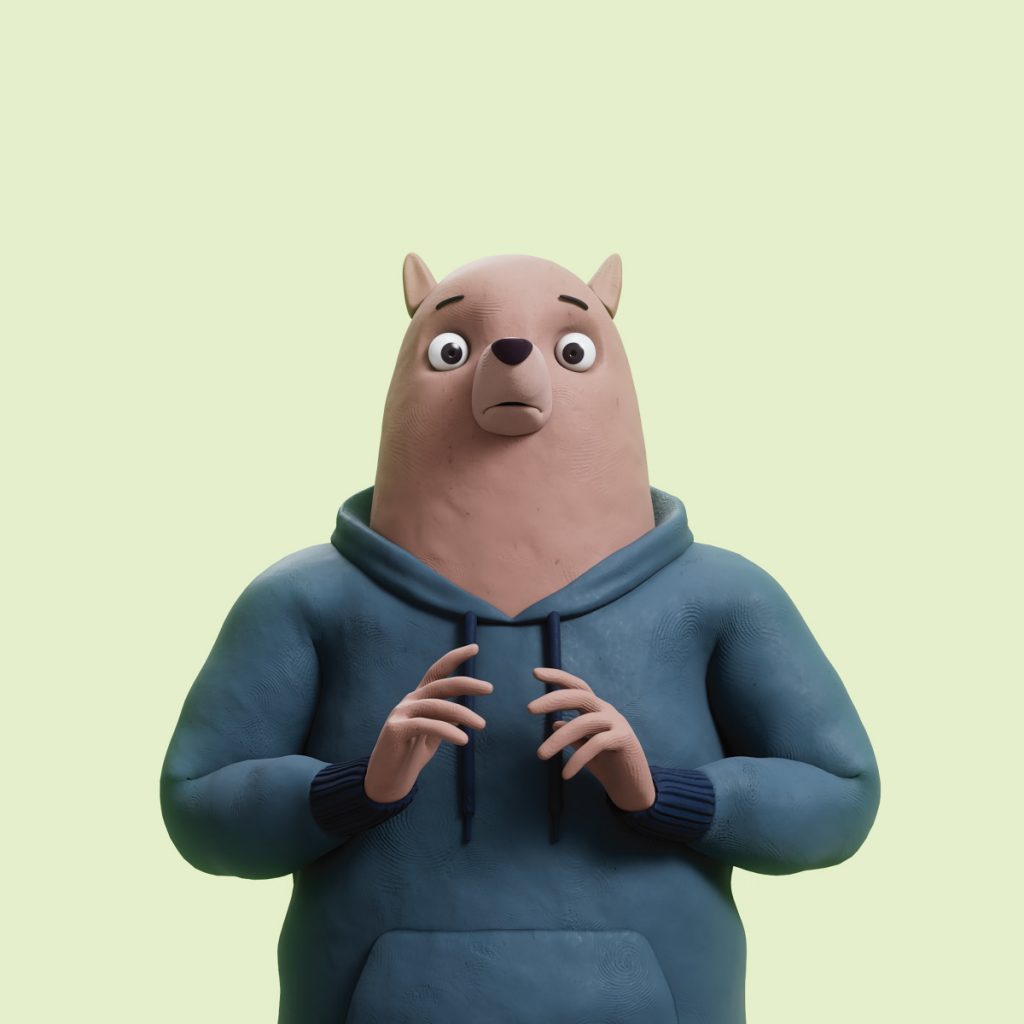Can animated stories help you to better understand your mental health needs?
What’s Up With Everyone? is a campaign run in conjunction with Aardman, research teams from various universities, and clinical and charitable partners to provide support for mental health literacy among young people. They believe that by sharing ideas relating to mental health and well-being in an engaging and popular format, animations can make a positive difference to the lives of young people
Talking about mental health and well-being is something that has grabbed the headlines in recent years and with good reason, not least during the coronavirus pandemic, when key reports have found increased levels of depression, anxiety and loneliness among young people. More than half of all students at university reported a worsening in their mental health and well-being since the beginning of the autumn term in September 2020. The Office of National Statistics found that in early 2021, adults aged 16 to 29 years were most likely to experience some form of depression (34%). A Young Minds survey found that 67% of young people believed that the pandemic will have a long-term negative effect on their mental health.
Clearly, these statistics are concerning, not least because issues relating to mental health and well-being in young people appear to be worsening. It is with these issues in mind that the What’s Up With Everyone? Campaign has been established. Led by Principal Investigator Professor Paul Crawford at The University of Nottingham’s Institute of Mental Health, with Aardman Animations Ltd, and research teams across the UK, the project seeks to provide young people with the tools, affirmation and empowerment (mental health literacy) to support their mental health needs before they develop into more serious issues.
WHO IS THE TARGET AUDIENCE FOR THE PROJECT?
This upstream project is composed of a variety of five animated stories that discuss life’s challenges and encourage people to realise that these are not unique to them. The target audience is primarily young people aged 17 – 24, who are likely in transition to college, university or the workplace, but it is not limited to this age range. Indeed, the films are available to younger audiences on Aardman’s YouTube Channel alongside Shaun the Sheep and other popular characters. Ultimately, by providing an engaging and popular format for the sharing of ideas relating to mental health and well-being, the team hopes to provide relevant support and understanding that can make a positive difference to the lives of young people.
WHO IS INVOLVED IN THE PRODUCTION OF THE ANIMATIONS?
Such an ambitious project requires input from a range of academic, clinical and creative industry experts. Of course, Aardman is one of the most famous and popular animation studios in the world, while Professor Paul Crawford is the world’s first professor of health humanities. However, given the target audience, young people were directly involved in the production of the animations. Accordingly, 42 young people, aged between 16 and 21 joined as co-creators, five of whom provided the spoken voices for each of the characters in the animations: Tai, Merve, Ashley, Charlie and Alex.
HOW WERE THE PRODUCERS RECRUITED AND WHAT WAS THEIR ROLE?
The young people involved in the production of the animations were recruited by Aardman with support from the Mental Health Foundation and Leaders Unlocked. This was achieved by contacting organisations that work with young people, universities and colleges across the UK, and through posts on social media. The young people actively contributed to the development of scripts in a co-creative pilot and workshops, and provided feedback on how their ideas had been translated into animated characters. The wider team prepared the website platform information with feedback from the young people.
HOW DID THE PROJECT TEAM DECIDE ON THE MENTAL HEALTH THEMES?
Paul and his colleagues are experts in the area of young people’s mental health and are acutely aware of the most commonly known areas of concern, notably perfectionism, loneliness & isolation, independence, social media, and competitiveness. These areas featured prominently in the feedback of nine young people in a co-creative pilot and in response to a mailer to 7,000 students sent out by Aardman.
The workshops that were a formative part of the project included diverse participants who helped in developing potential storylines and characters for the animated films. “The workshops confirmed the salience of the expected themes, and raised additional issues relating to loss of agency or being disempowered in decision-making and losing trust in adult frames for how to live their lives or what they called ticking the ‘grown up boxes’,” says Paul.
WHAT IMPACT HAS THE PROJECT HAD SO FAR?
The project has attracted multiple mainstream media coverage since it was released on 8 February 2021. By 12 March, there had already been substantial media coverage, including Sky News, ITV News, multiple BBC radio stations, BBC Teach, Daily Mail, Mental Health Today, The Psychologist, and Child and Adolescent Mental Health. In addition, key celebrities including Stephen Fry, Dr Alex George and Michael Chakraverty got behind the project, which has significantly expanded reach and increased awareness.
Over 17 million people have been reached across social media channels and through influencer posts, including 5 million young people. The project has built over 4.4k followers, a figure that continues to grow at a steady rate. More than 700k engaged with the content posted from Aardman channels, with 637k views across the channels. Excitingly, What’s Up With Everyone recently won Best Social Media & Content at the Design Week Awards! Clearly, the campaign is heading in the right direction and it follows that the more people know about it, the greater the positive effect will be.
WHAT DOES SUCCESS LOOK LIKE?
Paul is clear in his views of what will make the project successful. “We consider success to be offering visible, accessible resources to support mental health literacy among the largest possible audience in the target population in the UK and beyond,” says Paul. “From a research perspective, we wish to determine if animated stories and the website platform advance young people’s mental health literacy, and understand the mechanisms of digital storytelling. Preliminary findings show that the films improve young people’s knowledge and attitudes towards mental health, increase their willingness to seek help and their confidence in helping others.”
EXPLORE THE THEMES BEHIND THE PROJECT
Personal, Social, Health and Economic (PSHE) education is now compulsory in schools in the UK, which helps show how far we have come as a society in recognising the importance of providing pupils with the support and education they need to keep themselves healthy, safe and prepared for life.
In addition, the government has published statutory guidance in a document entitled Relationships, Education, Relationships and Sex Education and Health Education. Here, we delve deeper into the five themes that form part of the What’s Up With Everyone? project: perfectionism, loneliness & isolation, independence, social media, and competitiveness.
Reference
https://doi.org/10.33424/FUTURUM158
“We’re told it’s good to be competitive, right? But I’m starting to think that for me it’s getting a bit out of hand. I feel like whatever I’m doing, I have to be the best at it! If I’m not the best, or the fastest, or the funniest at something it starts to eat me up… I think it’s affecting my friendships, happiness and enjoyment of life. What’s up with me?” – Tai
“I know it sounds odd but even when I’m with friends I can feel shy and that I don’t have anything interesting to say… it can be a little scary… I can’t get my words out properly and I feel kind of out of it, not part of the group. I flip between longing to be in the company of others and wanting to hide away. I find it hard
responding to the thoughts that rattle around in my head. What’s up with me?” – Merve
“I have all these post-it notes stuck to my computer, reminding me to do things I never had to do before. They should all be quite simple on their own, but stacked up with all the other work, I’m finding it overwhelming and hard to cope. Other people seem
to manage okay. What’s up with me?” – Ashley
Clearly, these statistics are concerning, not least because issues relating to mental health and well-being in young people appear to be worsening. It is with these issues in mind that the What’s Up With Everyone? Campaign has been established. Led by Principal Investigator Professor Paul Crawford at The University of Nottingham’s Institute of Mental Health, with Aardman Animations Ltd, and research teams across the UK, the project seeks to provide young people with the tools, affirmation and empowerment (mental health literacy) to support their mental health needs before they develop into more serious issues.
WHO IS THE TARGET AUDIENCE FOR THE PROJECT?
This upstream project is composed of a variety of five animated stories that discuss life’s challenges and encourage people to realise that these are not unique to them. The target audience is primarily young people aged 17 – 24, who are likely in transition to college, university or the workplace, but it is not limited to this age range. Indeed, the films are available to younger audiences on Aardman’s YouTube Channel alongside Shaun the Sheep and other popular characters. Ultimately, by providing an engaging and popular format for the sharing of ideas relating to mental health and well-being, the team hopes to provide relevant support and understanding that can make a positive difference to the lives of young people.
WHO IS INVOLVED IN THE PRODUCTION OF THE ANIMATIONS?
Such an ambitious project requires input from a range of academic, clinical and creative industry experts. Of course, Aardman is one of the most famous and popular animation studios in the world, while Professor Paul Crawford is the world’s first professor of health humanities. However, given the target audience, young people were directly involved in the production of the animations. Accordingly, 42 young people, aged between 16 and 21 joined as co-creators, five of whom provided the spoken voices for each of the characters in the animations: Tai, Merve, Ashley, Charlie and Alex.
HOW WERE THE PRODUCERS RECRUITED AND WHAT WAS THEIR ROLE?
The young people involved in the production of the animations were recruited by Aardman with support from the Mental Health Foundation and Leaders Unlocked. This was achieved by contacting organisations that work with young people, universities and colleges across the UK, and through posts on social media. The young people actively contributed to the development of scripts in a co-creative pilot and workshops, and provided feedback on how their ideas had been translated into animated characters. The wider team prepared the website platform information with feedback from the young people.
HOW DID THE PROJECT TEAM DECIDE ON THE MENTAL HEALTH THEMES?
Paul and his colleagues are experts in the area of young people’s mental health and are acutely aware of the most commonly known areas of concern, notably perfectionism, loneliness & isolation, independence, social media, and competitiveness. These areas featured prominently in the feedback of nine young people in a co-creative pilot and in response to a mailer to 7,000 students sent out by Aardman.
The workshops that were a formative part of the project included diverse participants who helped in developing potential storylines and characters for the animated films. “The workshops confirmed the salience of the expected themes, and raised additional issues relating to loss of agency or being disempowered in decision-making and losing trust in adult frames for how to live their lives or what they called ticking the ‘grown up boxes’,” says Paul.
WHAT IMPACT HAS THE PROJECT HAD SO FAR?
The project has attracted multiple mainstream media coverage since it was released on 8 February 2021. By 12 March, there had already been substantial media coverage, including Sky News, ITV News, multiple BBC radio stations, BBC Teach, Daily Mail, Mental Health Today, The Psychologist, and Child and Adolescent Mental Health. In addition, key celebrities including Stephen Fry, Dr Alex George and Michael Chakraverty got behind the project, which has significantly expanded reach and increased awareness.
Over 17 million people have been reached across social media channels and through influencer posts, including 5 million young people. The project has built over 4.4k followers, a figure that continues to grow at a steady rate. More than 700k engaged with the content posted from Aardman channels, with 637k views across the channels. Excitingly, What’s Up With Everyone recently won Best Social Media & Content at the Design Week Awards! Clearly, the campaign is heading in the right direction and it follows that the more people know about it, the greater the positive effect will be.
WHAT DOES SUCCESS LOOK LIKE?
Paul is clear in his views of what will make the project successful. “We consider success to be offering visible, accessible resources to support mental health literacy among the largest possible audience in the target population in the UK and beyond,” says Paul. “From a research perspective, we wish to determine if animated stories and the website platform advance young people’s mental health literacy, and understand the mechanisms of digital storytelling. Preliminary findings show that the films improve young people’s knowledge and attitudes towards mental health, increase their willingness to seek help and their confidence in helping others.”
EXPLORE THE THEMES BEHIND THE PROJECT
Personal, Social, Health and Economic (PSHE) education is now compulsory in schools in the UK, which helps show how far we have come as a society in recognising the importance of providing pupils with the support and education they need to keep themselves healthy, safe and prepared for life.
In addition, the government has published statutory guidance in a document entitled Relationships, Education, Relationships and Sex Education and Health Education. Here, we delve deeper into the five themes that form part of the What’s Up With Everyone? project: perfectionism, loneliness & isolation, independence, social media, and competitiveness.
Where relevant, we have also presented some of the statutory guidance relating to PSHE.
PERFECTIONISM
Perfectionism is a personality characteristic that reflects a need to be perfect. This often exists alongside harsh self-criticism and there is evidence to show that perfectionism is on the rise; recent meta-analysis showed that perfectionism is rising rapidly among university-aged young people, with modelling suggesting that by 2050, almost one in three people will report clinically relevant levels of perfectionism.
WHY IS PERFECTIONISM POTENTIALLY PROBLEMATIC?
The latest research not only shows that incidence is on the rise, but that is contributes to a litany of serious mental health conditions, such as depression, anxiety, anorexia and suicide ideation.
LONELINESS & ISOLATION
Loneliness and isolation are issues usually associated with older people. Interestingly, the Loneliness & Isolation section of the What’s Up With Everyone? website is one of the most visited. While both loneliness and isolation can be a challenge for many people across their lives, especially older people who may have fewer social connections, young people are also badly affected. Moving to college, university or the workplace may pose a particular challenge to young people, as they navigate this transition. They may experience heightened anxiety about a number of issues, including their identity as they attempt to find their place in a world that puts a lot of emphasis on appearance and popularity, the threat of managing independently in the big world, forging a career pathway, and finding satisfying and supportive relationships.
The pressure to fit in and the intense focus on social experience can be overwhelming. This may be worse if a young person is already marginalised, without access to the resources of their peers (such as the internet), or when from minority communities, who may be subject to discrimination.
Statutory Guidance: Pupils should be supported to recognise what makes them feel lonely. Self-focused or isolating lifestyle choices can lead to unhappiness and being disconnected from society for those who have greater need for companionship and relationships.
INDEPENDENCE
Independence is usually regarded as a positive experience so why has independence been identified as a mental health challenge for young people? Becoming independent can certainly be a positive experience, but it is not without its challenges. Independence is all about making your own way in the world and involves acquiring new skills, taking risks and having the confidence to learn from your mistakes. Any challenges associated with living independently can be stressful and cause anxiety – and young people may feel that asking for help and support is a sign of weakness.
It is important to recognise that we all depend on other people to some extent, and others will always depend on us. The trick is to balance the desire for independence with the practicality of seeking and giving support to each other.
SOCIAL MEDIA
Much of the research we see and read about in the media is concerned with screen time and its associations with depression, anxiety and social isolation. However, recent advice to parents is not to just focus on screen time, but rather on the online content young people consume and how actively engaging (as opposed to passive scrolling) and creative engagement can have a positive effect.
IS THE IDEA OF COMPARING YOURSELF TO OTHERS THE REAL ISSUE HERE?
Many of the images and lives we are all presented with across social media are perceived standard that is impossible to live up to. However, there are also pressures to share opinions, personal information and photographs on an extreme scale – behaviours that are encouraged by persuasive loops of reward, duty, exchange and a need for validation. This need for ‘likes’ and ‘shares’ has decreased the quality of communication and increased social withdrawal, self-neglect, poor diet and family conflict.
Government, industry chiefs and technology designers are now incorporating new policies and guidelines to ensure social media platforms design their online services more responsibly and consider young people’s online rights, needs and developmental milestones.
Statutory Guidance: The internet and social media have important characteristics which young people should be aware of in order to help them use them discriminatingly. Secondary school pupils should know the similarities and differences between the online world and the physical world, and how to identify harmful behaviours online (including bullying, abuse or harassment) and how to report, or find support, if they have been affected by those behaviours.
COMPETITIVENESS
Competitiveness can certainly be a positive quality to have and levels of it clearly vary among individuals. However, we should recognise that it can be influenced by external factors, such as the number of competitors and the presence of audiences. Competitiveness can be problematic when someone is hypercompetitive.
Individuals who are hypercompetitive have a very strong urge to compete and win at all costs because winning is a big part of who they are. Hypercompetitiveness is related to low self-esteem, high neuroticism (a personality trait that tends towards anxiety, depression, self-doubt and other negative feelings), and high aggression. Other types of competitiveness can also be a problem if they cause people emotional distress.
Young people face more competitive environments these days, such as the job market and university admission, which could be related to the increased level of perfectionism seen in recent years. This is concerning because of its association with psychological disorders, such as depression and anxiety.
SEEKING HELP
Research has shown that there are many barriers to young people seeking help. These include:
- Stigma and embarrassment about seeking help
- Confidentiality and trust in relation to the potential source of help
- Difficulty identifying the symptoms of mental illness
- Lack of accessibility
- Preference to rely on themselves rather than seeking external help for their problems
- Concern about the characteristics of the potential provider of help
- Lack of knowledge about mental health services
- Fear about the act of seeking help or the source of help.
Statutory Guidance: Pupils should be taught how to judge when they, or someone they know, needs support and where they can seek help if they have concerns. This should include details on which adults in school and externally can help.
This is why the What’s Up With Everyone website has a ‘seeking help’ page, which gives students lots of options for finding support for any mental health problem they may have: www.whatsupwitheveryone.com/help.php
 PROJECT LEAD AND PRINCIPAL INVESTIGATOR
PROJECT LEAD AND PRINCIPAL INVESTIGATOR
Professor Paul Crawford
The University of Nottingham, UK
FUNDER: Arts and Humanities Research Council, What’s Up With Everyone [originally
What’s Up With Alex]? Animated Storytelling for Mental Health Literacy Among Young People (Grant number AH/T003804/1)

Do you have a question for the team?
Write it in the comments box below and they will get back to you. (Remember, researchers are very busy people, so you may have to wait a few days.)








Hi there, my name is Ethan. I’m a digital media student in my final year and conducting an experiment to see if animation can improve mental health. In the form of a guided meditation accompanied with satisfying and comforting animation. Would it be possible have an interview or even ask questions virtually to gain further insight to this topic? Any response would be greatly appreciated. I wish you all the best on your project!
Hi Ethan,
I am happy for Futurum to cc yiu into an email to me to respond further to questions on the project.
Kind regards
Paul